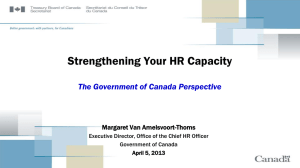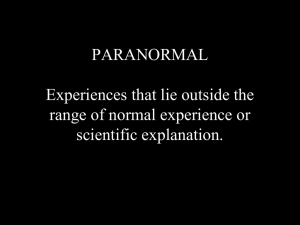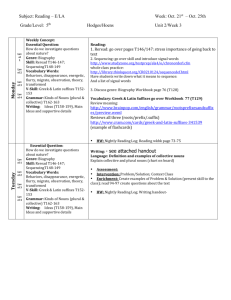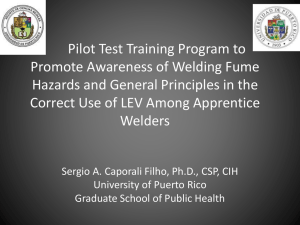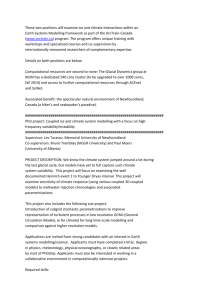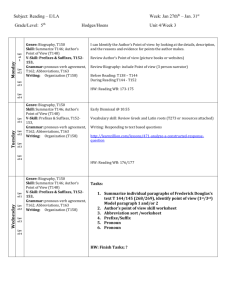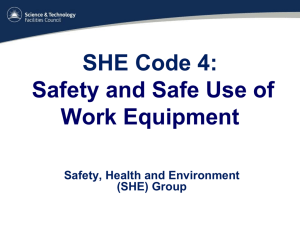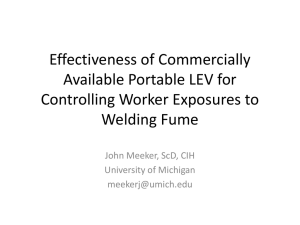Local Exhaust Ventilation (LEV) Standard
advertisement
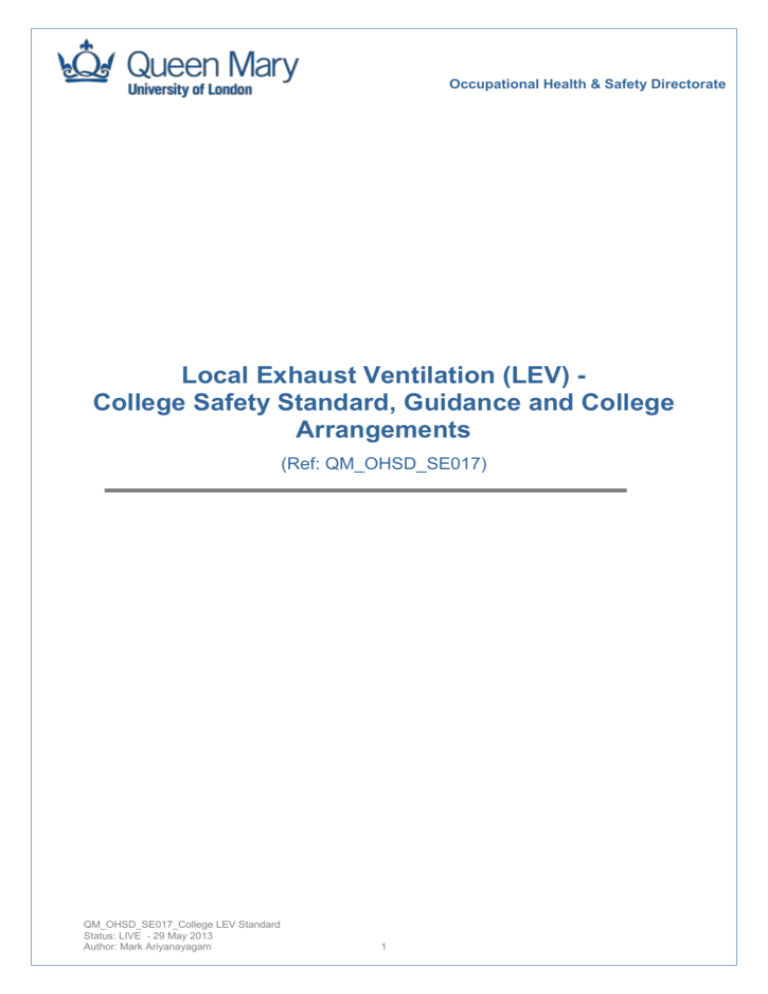
Occupational Health & Safety Directorate Local Exhaust Ventilation (LEV) College Safety Standard, Guidance and College Arrangements (Ref: QM_OHSD_SE017) QM_OHSD_SE017_College LEV Standard Status: LIVE - 29 May 2013 Author: Mark Ariyanayagam 1 Contents 1. Definition of Local Exhaust Ventilation (LEV) ............................................................ 3 2. College Statement of Policy on the selection, safe use and management of LEV .. 3 3. LEV - Applicable Legislation and Guidance ............................................................... 3 4. LEV Roles and Responsibilities .................................................................................. 4 5. 4.1 Head of School or Directorate / Director of Institute ................................................ 4 4.2 Laboratory Manager / Project or Maintenance Manager ......................................... 5 4.3 LEV system users ................................................................................................... 6 4.4 LEV supplier and designers .................................................................................... 7 4.5 LEV installers and commissioners .......................................................................... 7 4.6 LEV examiners / service engineers ......................................................................... 8 4.7 College Occupational Health and Safety Directorate............................................... 8 Competency for LEV Roles and Responsibilities ...................................................... 9 5.1 Head of School or Directorate / Director of Institute ................................................ 9 5.2 Laboratory Manager / Maintenance Manager / Project Manager ............................. 9 5.3 College Occupational Health and Safety Advisers .................................................. 9 5.4 LEV system users ................................................................................................. 10 5.5 LEV supplier and designers, LEV examiners / service engineers .......................... 10 6. LEV System monitoring ............................................................................................. 10 7. Health Surveillance for LEV use ............................................................................... 11 8. LEV Management Plan............................................................................................... 11 9. LEV Commissioning and Installation Records ........................................................ 11 10. LEV ‘Thorough Examination’ and Statutory Test .................................................... 12 11. College LEV Guidance documents ........................................................................... 13 11.1 Microbiological safety cabinets ............................................................................. 13 11.2 Fume Cupboards .................................................................................................. 13 12. Further LEV References and Useful Links ............................................................... 13 Appendix 1 LEV Management Plan – Model template .................................................... 15 Appendix 2 LEV Test labels ............................................................................................. 16 QM_OHSD_SE017_College LEV Standard Status: LIVE - 29 May 2013 Author: Mark Ariyanayagam 2 Local Exhaust Ventilation (LEV) 1. Definition of Local Exhaust Ventilation (LEV) Local Exhaust Ventilation (LEV) is defined as any engineering control system used to reduce exposure to airborne hazardous substances or contaminants in the workplace such as aerosols, dust, mist, fume, vapour or gas. Examples of LEV include microbiological safety cabinets, fume cupboards, ventilated workbenches, isolators, ventilated cages, containment / clean room extraction systems, snorkels, capture hoods and booths. This Standard applies to LEV required for the protection of human health and/or the environment. An LEV system typically consists of; 1. an inlet hood where the contaminant / hazardous substance is captured, 2. ducting which conducts the air and contaminants to a safe discharge point, 3. air cleaner or arrestor which filters or cleans the extracted air (not all LEV systems need this), 4. air mover typically a fan which powers the extraction system, 5. discharge which releases the extracted air to a safe place. College Statement of Policy on LEV 2. College Statement of Policy on the selection, safe use and management of LEV It is College policy that where it is not reasonably practicable to prevent exposure to air borne hazardous substances or contaminants, that engineered controls such as LEV systems are selected according to the risk assessment for the work in conjunction with statutory criteria, and are utilised to reduce human and/or environmental exposure to a level unlikely to cause harm. It is College policy that LEV systems are commissioned and installed to statutory requirements and industry standards; are used correctly by trained personnel; are tested according to statutory requirements, maintained in an efficient working order, kept in good repair and in a clean state. It is College policy that records of testing, inspection, examination and maintenance are kept, in conjunction with an LEV management plan. Standard 3. LEV - Applicable Legislation and Guidance This College Standard sets out the framework for the criteria and selection of suitable LEV equipment, safe use and management of LEV under the requirements of applicable health, safety and fire legislation. The general requirements of the Health and Safety at Work Act etc 1974, include the requirement for employers to ensure the health, safety and welfare of their employees and others affected by their work (so far as is reasonably practicable), and specifically that equipment provided for the health and safety of workers, is safe to use as intended. To protect human health and the environment, the Control of Substances Hazardous to Health Regulations 2002 (as amended) and the Genetically Modified Organisms (Contained Use) Regulations 2000 (as amended) stipulate provisions for LEV selection criteria, QM_OHSD_SE017_College LEV Standard Status: LIVE - 29 May 2013 Author: Mark Ariyanayagam 3 Standard thorough examination and testing, maintenance and safe use with substances hazardous to health and or the environment. The Provision and Use of Work Equipment Regulations 1998 (as amended), requires that equipment provided by the employer is fit for purpose, maintained for safe use and inspected to ensure its safety. The above legislation and the Management of Health and Safety at Work Regulations 1999 (as amended) in particular requires that competent advice is given / acquired to ensure safe working. In this context, the adequate competency of those selecting LEV equipment, those operating the equipment, and those supplying, maintaining and inspecting LEV equipment are identified as crucial requirements for safe working with, and effective management of, LEV systems. The Dangerous Substances and Explosive Atmospheres Regulations 2002, and Regulatory Reform Fire Safety Order 2005 stipulate that equipment and management arrangements in place to prevent and protect against fire and explosive risks must be effective. Where applicable, guidance such as Health and Safety Executive’s (HSE) ‘Controlling airborne contaminants at work’ (HSG 258) and industry standards (e.g. BS EN, ISO) are followed in this Standard. These are not statutes but the guidance they provide is considered acceptable practice by the HSE and other regulators or professional bodies. 4. LEV Roles and Responsibilities 4.1 Head of School or Directorate / Director of Institute The Head of School or Directorate / Director of Institute takes on the role for ‘employer responsibilities’ noted under H&S legislation. Actions or duties can be delegated to a suitably competent and authorised person (e.g. Lab Manager, Building Manager, competent LEV engineer, Project or Maintenance Manager), but the ‘employer responsibility’ remains with the Head of School or Directorate / Director of Institute. It is noted that for most College ducted LEV equipment, the Head of School or Director of Institute AND the Head of Estates & Facilities Directorate will be the joint ‘Responsible Person’, as most ducted systems are ‘co-owned’. It is the responsibility of the Head of School / Director of Institute and Head of Estates & Facilities to ensure that; 1. an LEV system is only used after considering other more effective control options through risk assessment of the tasks and hazardous substances / contaminants to be handled 2. The properties of the airborne contaminants / hazardous substances generated by the task are understood .to enable the selection of the most effective LEV and to understand its limitations for safety. 3. The needs of the operators and those working nearby and others who may be affected by the tasks, are incorporated into the risk assessment process to define the required safety and ergonomic standards. QM_OHSD_SE017_College LEV Standard Status: LIVE - 29 May 2013 Author: Mark Ariyanayagam 4 Standard 4. Competent assistance is obtained to ensure that the performance criteria are clearly laid out and that the most effective LEV system for safety is designed and selected. 5. The required financial and other resources are provided for the design, selection, installation and commissioning, servicing, repairs and end of life disposal (including potential decontamination costs). 6. A competent person (e.g. engineer or technician) is used to install and commission the system. 7. Commissioning installation records and system information are obtained from the competent installer / commissioner (see section 9.0). 8. Training for the safe operation of the system is arranged and provided for users and local safety rules of operation (including decontamination and emergency procedures) are in place. 9. Any health surveillance and health monitoring identified as required for the safe use of the LEV is provided to the user. 10. Statutory testing for all non-ducted LEV, and where identified servicing and repairs, are conducted by a competent person and records kept. 11. (Heads of School / Institute Directors and Head of Estates & Facilities Directorate) To liaise together to ensure all ducted LEV systems are tested IN FULL as required by statute by Estates or their competent contractors, and serviced and repaired as identified. 12. A management plan (see section 8.0) to ensure local inspections, statutory testing, servicing and repairs should be maintained and that it is available for College or Regulatory Authority audit and inspection. 13. Failed systems are removed from operation until repair or final disposal. 4.2 Laboratory Manager / Project or Maintenance Manager It is the responsibility of the Laboratory or Maintenance / Project or Maintenance Manager authorised by the Head of Institute or Directorate / Director of Institute to ensure that; 1. Duties allocated by the Head of Institute or Directorate / Director of Institute for the selection, design, installation, commissioning, safe operation, training and final disposal are competently carried out. 2. They are competent to undertake the duties required, and also understand the limitations of their competency and to seek advice from competent advisers. 3. They obtain appropriate training to increase their knowledge and experience of LEV systems. QM_OHSD_SE017_College LEV Standard Status: LIVE - 29 May 2013 Author: Mark Ariyanayagam 5 Standard 4. A management plan (see section 8.0) for LEV systems in their remit is in place to ensure local inspections and checks, statutory testing and where required, servicing and repairs are conducted within specified timescales, and that it is available for College and Regulatory Authority audit and inspection. 5. Local safety rules of operation (including decontamination, emergency procedures) are in maintained and kept up to date. 6. Commissioning and installation records (see section 9.0), statutory records of testing and records of servicing, repair, and final disposal are kept and are available for College and Regulatory Authority audit and inspection. 7. Permit to work system is in place to ensure service engineer / examiner safety during testing / servicing and to ensure return of the system in a safe condition. 8. They report all failures of LEV systems in their remit to Estates and affected users, and to ensure systems are taken out of use until repair by a competent person or final disposal. 9. They ensure reports of any accidents (e.g. exposure to hazardous substance) and incidents are made to the affected person’s line manager / Safety Coordinator and College Occupational Health and Safety Directorate by the prescribed route. 4.3 LEV system users It is the responsibility of LEV system users to ensure that they; 1. Know and understand the criteria for LEV use and its limitations for safety. 2. Know and understand the constituent parts of the LEV system and its safety critical features. 3. Obtain relevant training for safe operation of the system (including decontamination and emergency procedures). 4. Check and make a written record (see section 6.1) that the LEV system is working properly before they use it to contain or capture any material that is harmful to persons and/or the environment 5. Keep the LEV system clean, neat and tidy and clean up any small spillages during work 6. Where applicable, do not use the LEV work surface as a storage area for items. 7. Where applicable and according to the task risk assessment, wear prescribed personal protective equipment. QM_OHSD_SE017_College LEV Standard Status: LIVE - 29 May 2013 Author: Mark Ariyanayagam 6 Standard 8. Report failures of the LEV system to their line manager / lab manager and report any accidents (e.g. exposure to hazardous substance) or incidents to their line manager / Safety Coordinator and College Occupational Health and Safety Directorate by the prescribed route. 9. Do not use failed or condemned LEV systems until they are repaired and fully fit for use. 4.4 LEV supplier and designers It is the responsibility of LEV system suppliers and designers to ensure that they 1. Know and understand their roles and responsibilities and are competent and qualified to design and/or supply the required LEV system 2. Liaise effectively with the College client and installer / commissioner 3. Understand the College client’s requirements and provide the most effective LEV system for safety, location, use, and checks and maintenance. 4. Fully brief the College client on the system limitations 5. Provide in full to the College client, the specifications (see section 9.0) and documentation / information (e.g. user manual, log book) for the system, including airflow, duct, filter, air mover / cleaner, discharge, location, alarms and other instrumentation and maintenance schedule and statutory testing, decontamination and final disposal. 6. Provide to the College client, the specification for in-use performance checks. 4.5 LEV installers and commissioners In many cases, these may be the same competent person. They should ensure that they 1. Know and understand their roles and responsibilities and are competent and qualified to provide the installation and/or commissioning of the LEV system. 2. Liaise effectively with the College client and LEV supplier / designer. 3. Install and commission according to the statutory requirements, design and supply specification. 4. Know and understand if needed, how to modify the system design in line with the specification and statutory limitations to improve safety. 5. Provide installation, commissioning records (see section 9.0) and system information (e.g. system manual, user manual, log book, QM_OHSD_SE017_College LEV Standard Status: LIVE - 29 May 2013 Author: Mark Ariyanayagam 7 Standard benchmark criteria for future performance, including decontamination and final disposal) to the College Client. 4.6 LEV examiners / service engineers It is the responsibility of LEV system examiners and service engineers to ensure that they 1. Know and understand their roles and responsibilities and are competent and qualified to examine, test and / or service the LEV system. 2. Be fully knowledgeable of the LEV system, legal requirements for thorough examination, testing and servicing and the industry standards for examination, testing and servicing 3. Know how to identify system defects, under performance, and unsafe operations and measure the effectiveness of the system. 4. Know how to work safely during testing, examination and servicing and adhere to the permit to work system in place (including wearing of applicable personal protective equipment as identified by the task risk assessment and following required decontamination procedures). 5. To hand back the LEV system in a safe condition with required test and service records to the College Head of School or Directorate / Director of Institute (or their nominated duty holder), with any remaining defects and safety issues / required actions clearly identified in the examination / test report. 4.7 College Occupational Health and Safety Directorate 1. Provide College Standard and Guidance, tools and templates for the risk assessment, safe selection, safe use and disposal of LEV system/s. 2. Provide competent safety advice to Heads of Schools or Directorates / Director of Institutes and their nominated duty holders, on the H&S and Fire Safety Legislative requirements and Best Practice. 3. Audit and inspect College LEV systems in line with the College H&S and Fire Safety Audit and Inspection Standard and Schedules and provide recommendations to improve H&S and Fire Safety performance. 4. Facilitate and/or provide training for the safe use of LEV systems by College staff and students. 5. Where identified by risk assessment and in line with statutory requirements, provide or facilitate health surveillance and/or health monitoring for safe LEV operation by College staff and/or students. QM_OHSD_SE017_College LEV Standard Status: LIVE - 29 May 2013 Author: Mark Ariyanayagam 8 Standard 6. Keep their own competency and training up to date on LEV systems, knowledge and experience. 5. Competency for LEV Roles and Responsibilities The Management of Health and Safety at Work Regulations 1999 (as amended) and the Control of Substances Hazardous to Health (COSHH) 2002 (as amended), requires adequate competency of those that select, design, supply, manage, use, examine, service or test LEV systems. Competency means having the appropriate knowledge, capabilities and experience for the task and allocated role and responsibility. The following routes/methods are recommended to obtain adequate competency in the following roles: 5.1 Head of School or Directorate / Director of Institute Understanding the College Safety Standard for LEV and underpinning College H&S Policy & Framework. Briefing by research group leader / project or maintenance manager on proposed project remit / work task and requirements for LEV (e.g. in Planning Round, Project Working Group). Briefing by internal and/or external competent advisers on LEV system/s within the School / Directorate / Institute’s remit. 5.2 Laboratory Manager / Maintenance Manager / Project Manager Understanding the College Safety Standard for LEV and underpinning College H&S Policy & Framework. Where identified by training needs analysis, specific LEV technical / safety training (internal or external). Experience of operating LEV systems. Briefing by internal and/or external competent advisers on LEV system/s within the School / Directorate / Institute’s remit. Attendance and completion of College safety training courses (taught, online) that cover LEV system operation. Briefings from authorised users (e.g. research group leaders) on the research project / work task remit and requirements. Consulting HSE and relevant Industry LEV guidance 5.3 College Occupational Health and Safety Advisers Full awareness and understanding of H&S legal requirements for LEV and College H&S Policy and Standards. QM_OHSD_SE017_College LEV Standard Status: LIVE - 29 May 2013 Author: Mark Ariyanayagam 9 Standard Full awareness and understanding of HSE guidance on LEV and consulting relevant Industry guidance Where identified by training needs analysis, specific LEV technical / safety training (internal and/or external). Where applicable, experience of operating LEV systems and to maintain / update their ability to advise on their safe use. Obtaining briefings from authorised users (e.g. research group leaders, maintenance manager) on the research project / work task. 5.4 LEV system users Attendance and completion of College safety training courses (taught, online) that cover LEV system operation. Understanding and adhering to local safety operating rules 5.5 LEV supplier and designers, LEV examiners / service engineers Obtaining suitable industry qualifications applicable to the role ( e.g. as noted in HSG 258 and INDG 408 - BOHS Cert OH / Dip OH, BOHS P601 / 602; UKAS, CIBSE, HVCA, fire safety, technical and engineering qualifications) Demonstration of competency via recorded portfolio of LEV knowledge, experience and application (e.g. by Continual Professional Development). 6. LEV System monitoring 6.1 LEV user daily, weekly and monthly checks of effective operation should be made, as specified by the supplier’s in-use performance checks (written records of checks should be kept in a suitable format e.g. LEV log book). As described above in the roles and responsibilities, users must report system defects and failures to the lab manager, and not use the system until it is repaired and safe to use. 6.2 Local safety inspections conducted by Safety Coordinator / Lab Manager should check the standard of LEV systems, records of statutory tests and user adherence to the local safety rules. 6.3 Where the commissioning records and user manual have identified periodic air sampling tests for safety, these should be arranged and conducted by the LEV system owner (this may need competent advice and College Estates involvement) 6.4 Under the College H&S audit and inspection plan, HASMAP audits and peer review inspections will audit/inspect performance to the College LEV Safety Standard. 6.5 Regulatory Authorities (e.g. HSE, EA) may inspect LEV systems and statutory records. QM_OHSD_SE017_College LEV Standard Status: LIVE - 29 May 2013 Author: Mark Ariyanayagam 10 Standard 7. Health Surveillance for LEV use Where identified by risk assessment and in line with statutory requirements, the LEV system owner must arrange for adequate health surveillance and/or health monitoring for safe LEV operation by College staff and/or students. College Occupational Health Service must be contacted to ascertain the most effective health surveillance or monitoring. Contractors conducting statutory tests, examinations and servicing must ensure that adequate health surveillance is provided by their employer or if self-employed, arranged by themselves. Certification of this may be requested by the College Client. 8. LEV Management Plan The School / Directorate or Institute LEV Management Plan should contain the following and be easily accessible for College and Regulatory Authority inspections: LEV system location, type, make/model and serial number (e.g. asset register entry) Identification of hazardous substances and/or contaminants handled / used in LEV. Dates of statutory testing - past and forthcoming – to keep 5 years dates minimum (in certain instances it may be prudent to keep records for longer e.g. when system is/has been used with long half-life radioactive substances, Hazard Group 3 organisms) Location of Commissioning records, log book and user manual Records of statutory tests, repairs and maintenance (or location of filed records) Records of LEV modifications (or location of filed records) Records of User local training records (or location of filed records). An LEV Management Plan template model is provided at the end of the document (Appendix 1). Schools / Institutes and Directorates are recommended to incorporate and maintain records of the LEV Management Plan within an existing College electronic management system (e.g. School / Institute / Directorate asset register). 9. LEV Commissioning and Installation Records 1. A user manual with a general specification of what the LEV system is designed to control and how it achieves control. It should include: a description of the system with diagrams; QM_OHSD_SE017_College LEV Standard Status: LIVE - 29 May 2013 Author: Mark Ariyanayagam 11 Standard performance information from commissioning; a description of checks and maintenance and replacement schedules, including frequency; a listing of replaceable parts (and part numbers); a detailed description of the specific statutory ‘thorough examination and test’ requirements and exposure targets; signs of wear and control failure; a description of how operators should use the system so it works effectively. 2. A logbook that includes: schedules for regular checks and maintenance; records of regular checks, maintenance, replacements and repairs; checks of compliance with the correct way of working with the LEV system; the name of the person who made these checks. 3. A commissioning report that includes: diagrams and a description of the LEV, including test points; details of the LEV performance specification; results, such as pressures and velocities at stated points; calculations; written descriptions of the commissioning, the tests undertaken, and the outcome. Where necessary, this should include air sampling results; a description of how operators should use the system so it works effectively. 10. LEV ‘Thorough Examination’ and Statutory Test LEV systems need a ‘thorough examination’ and statutory test once each year (legally allowed a maximum of 14 months between tests) to make sure it works effectively, performs adequately and continues to protect users. Some LEV systems (such as those controlling more safety critical or high-hazard processes) need more frequent thorough examination and testing. The COSHH Regulations require more frequent testing for some processes (e.g. microbiological safety cabinets used with ACDP Hazard Group 3 organisms need to be tested every 6 months, certain sand / metal grinding operations need monthly or 3-monthly tests). See additional College Safety Standard / Guidance documents for further information and/or consult College H&S Advisers. A label indicating pass or fail (shown below) should be attached to the LEV system and the test report (or copy) of the test report kept easily accessible for inspection (near or attached to the LEV). HSE Guidance HSG 258 Chapter 10 (pp 60 - 64) available (free PDF download) at www.hse.gov.uk has full details of the ‘thorough examination’ and statutory test including the information that must be provided in the test report. See College LEV Guidance documents noted below for specific types of LEV and further details on ‘thorough examination and testing for those particular systems. QM_OHSD_SE017_College LEV Standard Status: LIVE - 29 May 2013 Author: Mark Ariyanayagam 12 Further LEV College Guidance, References and Useful Links 11. College LEV Guidance documents 11.1 Microbiological safety cabinets Procedures and Guidance Notes for working with biological agents and materials (Section B09 Microbiological Safety Cabinets, pp 4153) Available from http://qm-web.ohsd.qmul.ac.uk/standard/index.html 11.2 Fume Cupboards Within ‘Laboratory General Safety’ Available from http://qm-web.ohsd.qmul.ac.uk/standard/index.html Further specific LEV guidance documents will be made available on the OHSD website. 12. Further LEV References and Useful Links HSE LEV Guidance - downloadable PDF’s free from www.hse.gov.uk Controlling airborne contaminants at work: A guide to local exhaust ventilation (LEV) HSG258 HSE Books 2008 ISBN 978 0 7176 6298 2 Clearing the air: A simple guide to buying and using local exhaust ventilation (LEV). INDG 408 ISBN 9780717663019 HSE LEV micro-website http://www.hse.gov.uk/lev/ LEV calculator for LEV assessors (HSE) http://www.hse.gov.uk/lev/calculator.htm Time to clear the air! A workers’ pocket guide to local exhaust ventilation (LEV) Pocket card INDG409 HSE Books 2008 ISBN 978 0 7176 6300 2 Control of substances hazardous to health (Fifth edition). The Control of Substances Hazardous to Health Regulations 2002 (as amended). Approved Code of Practice and guidance L5 (Fifth edition) HSE Books 2005 ISBN 978 0 7176 2981 7 See also HSE’s COSHH essentials at www.coshh-essentials.org.uk Useful links Chartered Institution of Building Services Engineers (CIBSE) www.cibse.org . (Main professional engineering body offering qualifications and membership to ventilation engineers). QM_OHSD_SE017_College LEV Standard Status: LIVE - 29 May 2013 Author: Mark Ariyanayagam 13 Further LEV College Guidance, References and Useful Links Heating and Ventilating Contractors’ Association (HVCA) www.hvca.org.uk . (Main representative organisation for companies installing ventilation systems including LEV). British Occupational Hygiene Society (BOHS) www.bohs.org for help with process and source assessment and LEV design and specification, as well as qualifications in designing and testing LEV. Institution of Occupational Safety and Health (IOSH) www.iosh.co.uk . For general advice on choosing LEV systems. Safety Assessment Federation (SAFED) www.safed.co.uk (Represents many insurance companies doing independent engineering inspection and certification of machinery and equipment including LEV systems). Independent National Inspection and Testing Association (INITA) www.inita.org.uk . (Represents companies doing independent engineering inspection and certification of machinery and equipment including LEV systems). Solids Handling and Processing Association (SHAPA) www.shapa.co.uk . (Represents the major employers in LEV manufacturing). QM_OHSD_SE017_College LEV Standard Status: LIVE - 29 May 2013 Author: Mark Ariyanayagam 14 Appendix 1 - LEV Management Plan – Model template LEV Type (e.g. microbiological safety cabinet, fume cupboard, containment room extract) LEV Location (Campus, Building, Room) LEV Owner (Name and School / Institute / Directorate QM_OHSD_SE017_College LEV Standard Status: LIVE - 29 May 2013 Author: Mark Ariyanayagam LEV Make LEV Model LEV Serial Number Hazardous Substances / Contaminants handled in LEV 15 LEV Statutory test dates (5 years minimum) Location of LEV Commissioning and Installation Records Location of LEV Statutory Test Reports Location of LEV Modification, Service Records Location of LEV User Training Records Appendix 2 - LEV Test labels Example of an LEV test record label Example of a LEV "Failed" label QM_OHSD_SE017_College LEV Standard Status: LIVE - 29 May 2013 Author: Mark Ariyanayagam 16 Document Control Initial Data Author: Dr Mark Ariyanayagam Position: Health and Safety Manager (SEM Section, OHSD) Checked by: Mrs Marion Richards Position: Director Occupational Health & Safety Directorate (OHSD) College Consultation: 17 May 2013 – 28 May 2013 Approved by: Mrs Marion Richards Position: Director Occupational Health & Safety Directorate (OHSD) Signature: Status: LIVE Date of Issue: 29 May 2013 Version No. Date of alteration Details of changes and re-issue 1 2 3 QM_OHSD_SE017_College LEV Standard Status: LIVE - 29 May 2013 Author: Mark Ariyanayagam 17 Changes made by
